Saab 29 Video - Documentary
|
|
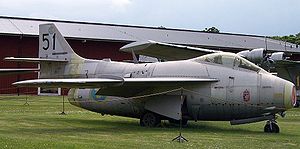 Picture: 29575 in the Swedish Air Force Museum
Picture: 29575 in the Swedish Air Force Museum
Role - Fighter aircraft
Manufacturer - Saab
First flight - 1 September 1948
Introduced - 1950
Retired - 1976
Primary users - Swedish Air Force
Austrian Air Force
Produced - 1950-1956
Number built - 661
The Saab 29, popularly called Flygande tunnan ("The Flying Barrel"), was a Swedish fighter designed and manufactured by Saab in the 1950s. It was Sweden's second turbojet-powered combat aircraft, the first being the Saab 21R. Despite its rotund appearance, the J 29 was fast and agile, serving effectively in both fighter and fighter-bomber roles into the 1970s.
Design and development
In the aftermath of the Second World War, it was decided that Sweden needed a strong air defense built around the newly developed jet propulsion technology. Project "JxR" began in the final months of 1945 with two proposals from the SAAB design team led by Lars Brising. The first, codenamed R101, was a cigar-shaped aircraft somewhat similar to the American P-80 Shooting Star. The winning design however was the "barrel" design, codenamed R1001, which proved to be both faster and more agile.
The original R1001 was designed around a mostly straight wing, but after the Swedish engineers had obtained some German research data on swept-wing designs, the prototype was altered to incorporate a 25 degree sweep, first tested on a modified Saab Safir (designated Saab 201). A member of the Saab engineering team had been allowed to review German aeronautical documents stored in Switzerland. These files captured by the Americans in 1945 clearly indicated delta and swept-wing designs had the effect of "reducing drag dramatically as the aircraft approached the sound barrier." [1]The SAAB 29 prototype flew for the first time on 1 September 1948. It was a small, chubby aircraft with a single central air intake, a bubble cockpit and a very thin swept-back wing. The test pilot was an Englishman, Robert A. "Bob" Moore, who went on to become the first managing director of Saab GB Ltd, UK, set up in 1960.
Moore described the aircraft as "on the ground an ugly duckling – in the air, a swift." Because of its rotund appearance, The Saab J 29 was quickly nicknamed "Flygande Tunnan" ("The Flying Barrel"). A total of 661 Tunnans were built from 1950 to 1956, making it the largest production run for any SAAB aircraft.
Operational history
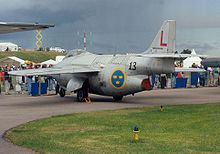 Picture: Saab Tunnan at Linköping, on the occasion of SAAB's Diamond Jubilee, in 1997
Picture: Saab Tunnan at Linköping, on the occasion of SAAB's Diamond Jubilee, in 1997
The J 29 was one of the first production fighters with a swept-back wing. It was fast and agile. The Tunnan set the world speed record on a 500 km (310 mile) closed circuit in 1954[2] at 977 km/h (607.05 mph). Two S 29C (reconnaissance variant) additionally set an international speed record of 900.6 km/h (559.4 mph) over a 1,000 km (621 mile) closed-circuit course in 1955.[2] In the 1950s, the Swedish Air Force, Flygvapnet, primarily using the J 29, was ranked as the fourth most powerful air force in the world.
The crash record in early service was poor, mainly due to the inexperience with swept-winged aircraft and the lack of a modern swept wing trainer. Pilots flew dual command Vampires before being put in the single seat Tunnan. The fighter version was retired from active service in 1965, but some aircraft were used for target towing up to 1974. The last official military flight was completed in August 1976 at the 50th anniversary air show of the Swedish Air Force.
A total of 30 Tunnans were sold to Austria in 1961 where they remained in service until 1972.
Picture: Tunnan's African war service
The Tunnan was the first and only Swedish jet aircraft to fight in combat. In 1961, five J 29Bs were stationed in the Democratic Republic of the Congo for a UN peacekeeping mission (ONUC), organized as the F 22 Wing of the Swedish Air Force. It was reinforced by four J 29B and two S 29C (the photo reconnaissance version) in 1962. Most of the missions involved attacking ground targets with internal cannons as well as unguided rockets. No aircraft were lost in action despite large amounts of AAA. Consensus of the crews and foreign observers was that the Tunnan's capabilities were exceptional.[3][4] (Their secessionist adversaries used a few Fouga Magisters and other aircraft with relatively poor air combat capabilities.) The only aircraft lost was by a high-ranking officer who made a trial-run and crashed during an aborted takeoff. When ONUC was terminated in 1964, some of the Swedish aircraft were destroyed at their base, since they were no longer needed at home and the cost of taking them all back was deemed excessive.
Variants
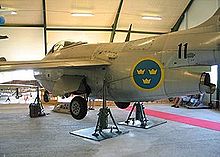 Picture: Saab S 29C preserved in an aviation museum
Picture: Saab S 29C preserved in an aviation museum
J 29
- Four prototypes built in 1949–1950.
J 29A
- Fighter, 224 built from 1951 to 1954; later series had wing-mounted dive brakes moved to the fuselage, ahead of the main landing gear doors.
J 29B
- Fighter, 332 built 1953–1955; featured 50% larger fuel capacity and underwing hardpoints to carry bombs, rockets and drop-tanks.
A 29B
- Same aircraft as the J 29B, but different use.
S 29C
- Reconnaissance ("S" was derived from Spaning; either scouting or reconnaissance in Swedish), 76 built from 1954 through 1956; five cameras
mounted in a modified nose (no armament was carried). This variant primarily operated at low level and was differentiated by having dark brown and dark
green camouflage on the topsides wherein other variants were unpainted.
J 29D
- Single prototype to test Ghost RM2A turbojet with 27.5 kN (2,800 kgp / 6,175 lbf) afterburning thrust; project abandoned in 1961.
J 29E
- Fighter, 29 built in 1955; incorporated a "dog-tooth" instead of wing slats.
J 29F
- Fighter, 308 aircraft converted from available stocks from 1954 to 1956; featured the afterburning Ghost and dog-tooth wing; all remaining aircraft
were further modified in 1963 to carry a pair of US-designed AIM-9B Sidewinder heat-seeking air-to-air missiles, built by SAAB under license as the "Rb
24."
Operators
Austria
Austrian Air Force
Sweden
Swedish Air Force
- F 3 Malmslätt
- F 4 Frösön
- F 6 Karlsborg
- F 7 Såtenäs
- F 8 Barkarby
- F 9 Säve
- F 10 Ängelholm
- F 11 Nyköping
- F 12 Kalmar
- F 13 Norrköping
- F 15 Söderhamn
- F 16 Uppsala
- F 21 Luleå
United Nations ONUC
Swedish Air Force
- F 22 Congo
Survivors
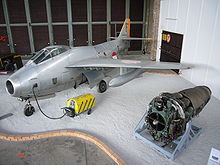 Picture: A J 29F Yellow F
Picture: A J 29F Yellow F
J 29A, 29203 in Svedinos Bil- och Flygmuseum, Ugglarp, Sweden
J 29B, 29398 in the Swedish Air Force Museum at F 3 Malmslätt, just outside of Linköping, Sweden
J 29F, 29670 in the Swedish Air Force Museum Airworthy as SE-DXB. Based at former Air Force base F 14 Halmstad.
J 29F, 29575 in the Swedish Air Force Museum. See the picture in the infobox.
J 29F, 29640 Midland Air Museum, Coventry, Only example currently in the UK.
J 29F, 29657 National Air and Space Museum, Only example currently in the US.
J 29F, 29543 at the Italian Air Force museum at Vigna di Valle.
J 29F, 29588 formerly in the Österreichisches Luftfahrt-Museum, Graz-Thalerhof in Austria.
Specifications (Saab J 29F Tunnan)
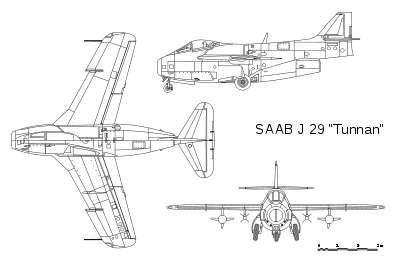 Picture: SAAB J 29 Tunnan - 3D drawing
Picture: SAAB J 29 Tunnan - 3D drawing
Data from The Great Book of Fighters[5]
General characteristics
Crew: One
Length: 11.0 m (36 ft 1 in)
Wingspan: 10.23 m (33 ft 7 in)
Height: 3.75 m (12 ft 4 in)
Wing area: 24.15 m² (260.0 ft²)
Empty weight: 4,845 kg (10,680 lb)
Max takeoff weight: 8,375 kg (18,465 lb)
Powerplant: 1× Volvo Aero RM2B turbojet, 6,070 lbf (27 kN)
Performance
Maximum speed: 1,060 km/h (660 mph)
Range: 1,100 km (685 mi)
Rate of climb: 32.1 m/s (6,320 ft/min)
Armament
4x Hispano Mark V 20 mm cannons
75 mm (3 in) unguided rockets
Rb 24 air-to-air missiles
145 mm (5.8 in) anti-armor rockets, 150 mm (6 in) HE (high-explosive) rockets, 180 mm (7.2 in) HE antiship rockets
Related development
Messerschmitt Me P.1101
Bell X-5
Comparable aircraft
P-80 Shooting Star
Dassault Ouragan
F-86 Sabre
MiG-15
Pulqui II
References
Notes
1. ^ Erichs et al. 1988, p. 37.
2. ^ a b records.fai.org/general_aviation/aircraft "General Aviation World Records: Saab J 29." Fédération Aéronautique
Internationale (FAI). Retrieved: 18 February 2009.
3. ^ J 29 - SAAB 29 ”Flygande tunnan” (1951-1976) www.avrosys.nu.
4. ^ J 29 Tunnan www.everything2.com.
5. ^ Green, William and Gordon Swanborough. The Great Book of Fighters. St. Paul, Minnesota: MBI Publishing, 2001. ISBN 0-7603-1194-3.
Bibliography
Berns, Lennart and Robin Lindholm. "Saab J 29 Tunnan". International Air Power Review, Volume 13 / 2004, pp. 152–173.
Erichs, Rolph et al. The Saab-Scania Story. Stockholm: Streiffert & Co., 1988. ISBN 91-7886-014-8.
Taylor, John W.R. "Saab J 29." Combat Aircraft of the World from 1909 to the present. New York: G.P. Putnam's Sons, 1969. ISBN 0-425-03633-2.
This Happens in the Swedish Air Force (brochure). Stockholm: Information Department of the Air Staff, Flygstabens informationsavdelning, Swedish Air
Force, 1983.
Widfeldt, Bo. The Saab J 29. Leatherhead, Surrey, UK: Profile Publications Ltd., 1966.
Winchester, Jim. "Saab J 29". Military Aircraft of the Cold War (The Aviation Factfile). Rochester, Kent, UK: The Grange plc., 2006. ISBN 1-84013-929-7.
Living Warbirds: The best warbirds DVD series.
Source: WikiPedia